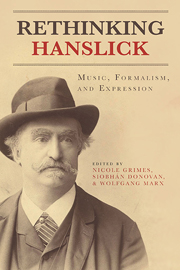Book contents
- Frontmatter
- Contents
- Foreword by Mark Evan Bonds
- Acknowledgments
- Abbreviations
- Chronology
- Introduction
- Part One Rules of Engagement
- 1 Negotiating the “Absolute”: Hanslick's Path through Musical History
- 2 Hanslick's Composers
- 3 Hanslick, Legal Processes, and Scientific Methodologies: How Not to Construct an Ontology of Music
- 4 Otakar Hostinský, the Beautiful, and the Gesamtkunstwerk
- Part Two Liberalism and Societal Order
- Part Three Memoirs and Meaning in Social Contexts
- Part Four Critical Battlefields
- Selected Bibliography
- List of Contributors
- Index
3 - Hanslick, Legal Processes, and Scientific Methodologies: How Not to Construct an Ontology of Music
from Part One - Rules of Engagement
Published online by Cambridge University Press: 05 July 2013
- Frontmatter
- Contents
- Foreword by Mark Evan Bonds
- Acknowledgments
- Abbreviations
- Chronology
- Introduction
- Part One Rules of Engagement
- 1 Negotiating the “Absolute”: Hanslick's Path through Musical History
- 2 Hanslick's Composers
- 3 Hanslick, Legal Processes, and Scientific Methodologies: How Not to Construct an Ontology of Music
- 4 Otakar Hostinský, the Beautiful, and the Gesamtkunstwerk
- Part Two Liberalism and Societal Order
- Part Three Memoirs and Meaning in Social Contexts
- Part Four Critical Battlefields
- Selected Bibliography
- List of Contributors
- Index
Summary
Hanslick’s Dilemma: The Ingredients of Music
As Hanslick himself tells us, his treatise On the Musically Beautiful contains both a positive thesis and a negative one. The positive thesis is concerned with what music is—the content of music consists solely of tonally moving forms, and musical beauty is of a special kind found only in music. The negative thesis is concerned with what music is not—distinct emotions are not part of the content of music, nor are the feelings conveyed by the composer or the performer, or felt by the listener. Curiously, the book has much more to say about the negative thesis than the positive one, and this essay will attempt to establish exactly why this should be so, and what consequences that imbalance has for Hanslick's views about the nature of music. Moreover, it should be noted that we will follow (at least initially) the usual line here by tacitly implying that his arguments explore directly the issue of the “ontology” of music. Technically, however, they seem to have more to do with the identifying characteristics of music and the individuation of particular works, than with how music “exists” as an entity in the universe, as it were. We will return to aspects of this issue in the final section.
- Type
- Chapter
- Information
- Rethinking HanslickMusic, Formalism, and Expression, pp. 52 - 69Publisher: Boydell & BrewerPrint publication year: 2013



